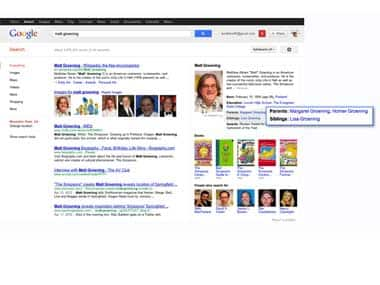Google
today announced that it was going to spruce up search results
by adding a new feature called the Knowledge Graph. The new feature which was released on Wednesday will draw from a Google-built database of more than 500 million people, places and commonly requested things to provide a summary of vital information alongside the main search results. According to reports, the search engine spent the past two years crawling Wikipedia, the CIA Factbook and other sources to expand a database of 12 million items that it picked up as part of its 2010 acquisition of Metaweb. So what should users expect with Google’s new Knowledge Graph. Here’s a heads-up: More relevant results: As Google’s Amit Singhal,
writes on the Google blog:
This is a critical first step towards building the next generation of search, which taps into the collective intelligence of the web and understands the world a bit more like people do. The Knowledge Graph is part of larger attempt by Google to give more relevant and niche results to users and to filter out content that seems irrelevant. So basically, Google’s latest step is a continuation of its drive to give users more relevant results and try to filter out all those spammy pages. Last year,
Google had launched Panda
as part of its search algorithm to ensure low quality sites are kept out of rankings. [caption id=“attachment_312289” align=“alignleft” width=“380” caption=“The fun factbox in the new Google search. Screengrab”]
 [/caption] Intelligent search: It seems Google will now take different meanings of the same search terms into consideration when displaying the search results. This means that if a word has more than one meaning, Google will give the user the option to switch to what they mean. For instance the difference between Taj Mahal the monument and the Taj Hotels will be much clearer and the Knowledge Graph will try and highlight what the user means. The Unexpected Factbox: According to the developers, the Knowledge Graph will also help users make some unexpected discoveries. For instance if there is a fun, unknown fact about a term query, Google’s Knowledge Graph will highlight that in a separate box for the user. Google is trying hard to make search more intelligent, more niche and a bit of a surprise for the user. The attempt is to try and contextualise search queries of users by giving a rich information content around it. So if one searches for say Krishna on Google, the right-hand panel won’t just show the small Wikipedia page on Krishna, but it will also give related links to Krishna, such as videos, and other figures people might have searched for while looking up Krishna. Google’s latest move comes after
Microsoft revamped Bing
by including social media results from Facebook on the right-hand side panel. Bing will now have a new, three-column screen design with the right hand column showing users’ Facebook friends and giving them the option of asking their advice on a search on the right. Google also displays links that a user’s friends have shared on Google Plus in search but Plus is nowhere as popular as Facebook. Google certainly can’t be worried about Bing as it is nowhere close to being a competitor. The Knowledge Graph however can be seen as a step to ensure that Google remains comfortably on top.
[/caption] Intelligent search: It seems Google will now take different meanings of the same search terms into consideration when displaying the search results. This means that if a word has more than one meaning, Google will give the user the option to switch to what they mean. For instance the difference between Taj Mahal the monument and the Taj Hotels will be much clearer and the Knowledge Graph will try and highlight what the user means. The Unexpected Factbox: According to the developers, the Knowledge Graph will also help users make some unexpected discoveries. For instance if there is a fun, unknown fact about a term query, Google’s Knowledge Graph will highlight that in a separate box for the user. Google is trying hard to make search more intelligent, more niche and a bit of a surprise for the user. The attempt is to try and contextualise search queries of users by giving a rich information content around it. So if one searches for say Krishna on Google, the right-hand panel won’t just show the small Wikipedia page on Krishna, but it will also give related links to Krishna, such as videos, and other figures people might have searched for while looking up Krishna. Google’s latest move comes after
Microsoft revamped Bing
by including social media results from Facebook on the right-hand side panel. Bing will now have a new, three-column screen design with the right hand column showing users’ Facebook friends and giving them the option of asking their advice on a search on the right. Google also displays links that a user’s friends have shared on Google Plus in search but Plus is nowhere as popular as Facebook. Google certainly can’t be worried about Bing as it is nowhere close to being a competitor. The Knowledge Graph however can be seen as a step to ensure that Google remains comfortably on top.
Google's Knowledge Graph: What to expect
FP Staff
• May 17, 2012, 14:14:40 IST
The new feature which was released on Wednesday will draw from a Google-built database of more than 500 million people, places and commonly requested things to provide a summary of vital information alongside the main search results.
Advertisement
)
End of Article